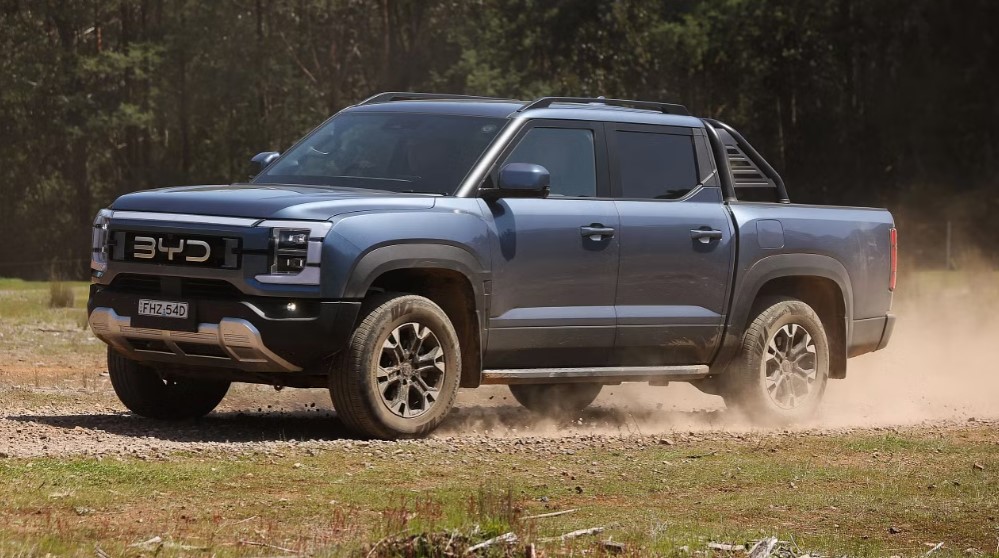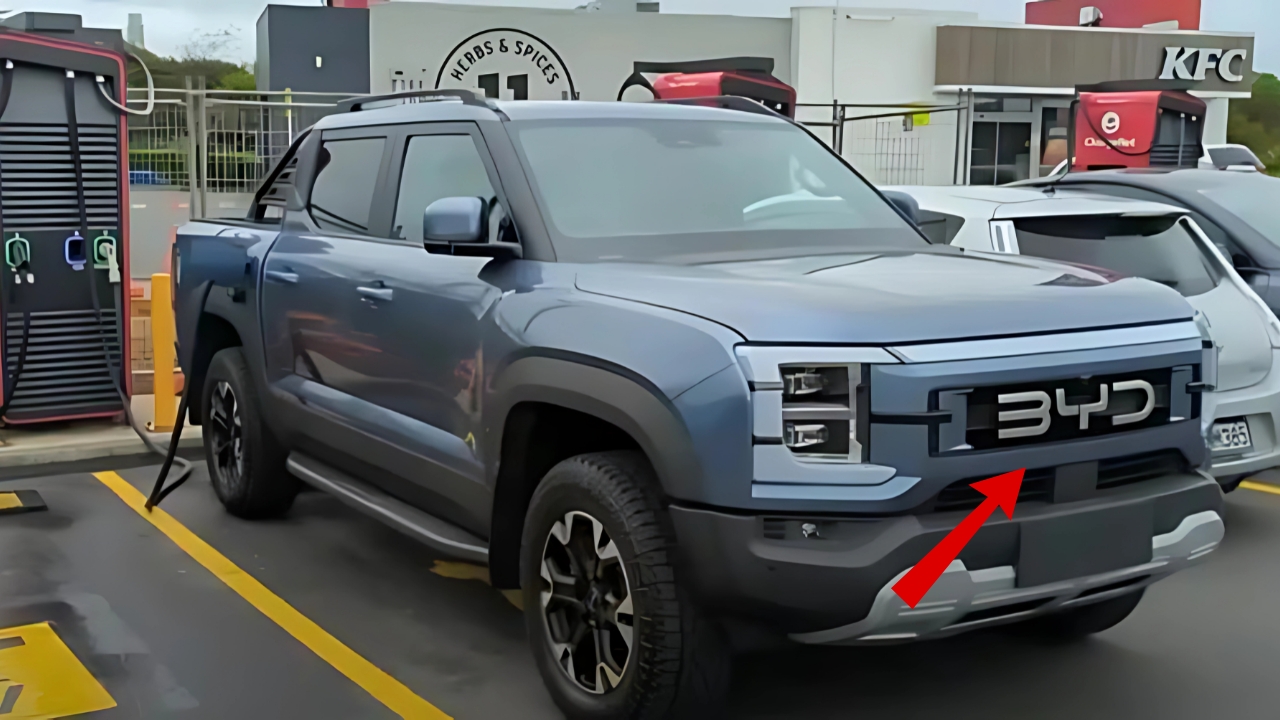The Australian ute market has experienced a seismic shift with the arrival of the BYD Shark 6 and its revolutionary Dual Motor Intelligence system. This groundbreaking vehicle delivers an impressive 100km electric-only range while maintaining the rugged capabilities that Aussie drivers demand from their dual-cab workhorses.
At $57,900 before on-road costs, this electrified powerhouse undercuts established rivals like the Ford Ranger XLT Bi-Turbo ($63,640) and Toyota HiLux SR5 V-Active ($63,260), making it a compelling proposition for both tradies and weekend warriors.
What Makes the Dual Motor System Special?
The DM-O Technology Breakdown
BYD’s DM-O (Dual Mode Off-road) system represents a complete departure from traditional diesel-powered utes. The system comprises a 1.5-litre turbo-petrol engine, an electric motor on each axle and a 29.5kWh LFP battery pack mounted into the traditional ladder frame chassis.
This isn’t just another hybrid setup thrown together as an afterthought. The dual electric motors work independently on each axle, providing instant torque delivery and precise traction control that traditional mechanical systems simply cannot match.
Power That’ll Blow Your Mind
The numbers speak for themselves: 321kW of combined power and a staggering 650Nm of torque. BYD claims the Shark 6 can sprint from 0-100km/h in just 5.7 seconds, an impressive feat considering its 2710kg kerb weight.
To put that in perspective, that’s faster acceleration than a Ford Ranger Raptor – pretty impressive for a vehicle that can also run purely on electricity for your daily commute.
Real-World Performance in Australian Conditions
The 100km Electric Range Reality Check

The 2025 BYD Shark 6 has a 29.58kWh battery claimed to provide up to 100km of EV-only range. However, that’s using the NEDC measurement; expect something closer to 80km in real world driving.
While 80km might seem modest compared to pure EVs, it’s perfect for most Australian work scenarios. Think about it – that covers the daily commute for most tradies, plus local job runs, all without burning a drop of fuel.
Fuel Economy That Actually Makes Sense
Here’s where things get seriously impressive. BYD suggests with plenty of charge in the battery the car will use a claimed average of 2.0 litres of petrol per 100km travelled, which is very, very efficient.
Even when the battery runs low and you’re in full hybrid mode, the company claims fuel use of 7.9L/100km – comparable to traditional diesel utes but with significantly more power and refinement.
How the Dual Motor System Actually Works
Electric-First Philosophy
If the battery charge is above 25 per cent, the Shark will typically use only its two electric motors to drive the wheels. This means for most daily driving, you’re essentially piloting a silent, emissions-free electric vehicle.
The 1.5-litre turbo engine primarily acts as a range-extending generator, only directly driving the wheels in specific high-speed scenarios above 70km/h.
Smart Terrain Management
The Shark 6’s terrain modes leverage the dual motor setup brilliantly:
Gravel Mode: Optimizes traction and power distribution for loose surfaces Mud Mode: Adjusts torque to wheels with the most grip Sand Mode: Increases throttle response to maintain momentum
BYD reckons the instant electric torque and traction control ensures the Shark 6 can tackle most off-road obstacles without traditional low-range gearing or differential locks.
Comparing Against the Competition
Value Proposition That’s Hard to Ignore
The Shark 6 stacks up very well on the price/equipment equation with key rivals. Essentially, it comes in at Ford Ranger XLT pricing with Ranger Platinum gear – a vehicle that typically costs around $20,000 more.
Towing and Payload Considerations
The 2500kg braked towing capacity is the Shark’s main compromise compared to traditional 3500kg-rated utes. However, the 835kg payload remains competitive, and for many users, that towing capacity is more than adequate.
The 835kg payload is competitive, but maximum towing is only 2500kg rather than the usual 3500kg, so heavy machinery haulers might need to look elsewhere.
Technology and Features That Impress
Interior Tech That Rivals Premium Cars
The 15.6-inch rotating touchscreen takes center stage, offering seamless wireless Apple CarPlay and Android Auto integration. The 10.25-inch digital instrument cluster provides crystal-clear information display.
Heated and ventilated seats, wireless phone charging, and a 12-speaker Dynaudio sound system create a premium cabin environment that puts many luxury vehicles to shame.
Vehicle-to-Load: Your Mobile Power Station
The Shark also features vehicle-to-load (V2L) tech that allows household AC appliances and camping gear to be powered from regular powerpoints. All up the system can provide up to 6kW of power.
This feature transforms your ute into a mobile generator, perfect for worksites without power access or extended camping adventures.
Real-World Testing and Current Availability
Australian Market Reception
The lucky first Aussie recipient of an all-new Shark 6 – Ben Hillier from Brisbane – ordered his vehicle the night the vehicle was launched in late October. First deliveries commenced in December 2024 and January 2025.
Partnership with Ironman 4×4
BYD’s local distributor EVDirect has partnered with Australian-based off-road accessory company Ironman 4×4 for the Shark 6, and the first 2000 customers will get a $500 credit towards accessories.
This partnership ensures that genuine Australian-tested accessories are available from day one, addressing concerns about aftermarket support.
Suspension and Ride Quality Revolution
Independent Suspension All Round
Unlike traditional utes with leaf springs and live rear axles, the Shark has independent coil-sprung rear end. This should pay dividends in terms of on-road comfort and handling.
The double wishbone suspension at both the front and rear delivers SUV-like comfort, setting it apart from traditional utes, which often feel harsher on the road.
Chassis Rigidity Through Battery Integration
This enhanced torsional stiffness is achieved by incorporating the vehicle’s Blade Battery into the chassis itself, which significantly increases the structural integrity.
This Cell-to-Chassis (CTC) technology creates a stiffer platform than traditional body-on-frame construction while maintaining the ruggedness required for commercial use.
Safety and Warranty Considerations
Comprehensive Coverage
The BYD Shark 6 will likely be covered by the same six-year, 150,000-kilometre vehicle warranty and eight-year, 160,000-kilometre battery warranty as the rest of the carmaker’s lineup.
Expected Safety Performance
BYD has a perfect record of five-star ratings so far with Australian-market vehicles, and the Shark 6 includes comprehensive active safety systems including autonomous emergency braking, blind-spot monitoring, and adaptive cruise control.
Market Impact and Future Implications
Sales Performance
BYD has shifted 6129 Sharks so far this year, well ahead of the next-closest Sealion 6 PHEV at 2358, indicating strong market acceptance despite its unconventional powertrain.
Industry Disruption
The BYD Shark 6 is not just a huge step for BYD, it’s possibly one of the most important products launched in Australia in recent years. The success of this vehicle could accelerate electrification across the entire ute segment.
The Bottom Line for Australian Buyers
The BYD Shark 6’s Dual Motor Intelligence system represents a fundamental shift in how we think about work vehicles. With its 100km electric range, massive power output, and competitive pricing, it offers a compelling alternative to traditional diesel utes.
While the reduced towing capacity might limit its appeal for some heavy-duty applications, the combination of daily running cost savings, impressive technology, and genuine off-road capability makes it a serious contender for the majority of Australian ute buyers.
The question isn’t whether the Shark 6 will succeed – early sales figures suggest it already has. The question is how quickly the established manufacturers will respond to this electric revolution in Australia’s most conservative vehicle segment.
Frequently Asked Questions
Q: Can the BYD Shark 6 really achieve 100km electric range in Australian conditions? A: Real-world testing suggests closer to 80km under typical Australian driving conditions, which is still excellent for daily commuting.
Q: How does the dual motor system perform off-road without low-range gearing? A: The instant electric torque and sophisticated traction control system provide excellent off-road capability for moderate terrain, though serious rock crawling might favor traditional systems.
Q: What’s the real-world fuel consumption like? A: With a charged battery, expect around 2.0L/100km for normal driving. In hybrid mode with low battery, consumption averages 7.9L/100km.

